Straits Settlements |
|
|
|
| Übersicht – Contents: | |
Straits Settlements |
|
|
|
| Übersicht – Contents: | |
Flaggen – Flags: |
|
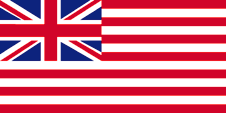 |
1826–1858, Flagge der Britischen Ostindienkompanie – flag of British East India Company, Seitenverhältnis – ratio = 1:2, Quelle/Source, nach/by: commons.wikimedia.org |
 |
1858–1946, Union Flag → quasi Nationalflagge, |
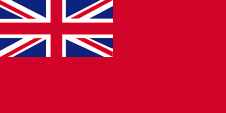 |
1867–1946, |
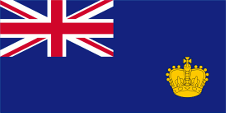 |
1868–1877, Flagge der Regierung (Staatsflagge) – flag of the government (state flag), Seitenverhältnis – ratio = 1:2, Quelle/Source, nach/by: Flags of the World   |
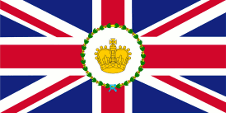 |
1868–1877, Flagge des Gouverneurs – flag of the Governor, Seitenverhältnis – ratio = 1:2, Quelle/Source, nach/by: Flags of the World |
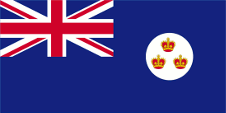 |
1877–1879,(?) unsicher – uncertain, Flagge der Regierung (Staatsflagge) – flag of the government (state flag), Seitenverhältnis – ratio = 1:2, Quelle/Source, nach/by: Flags of the World   |
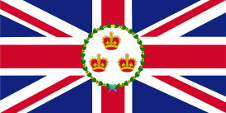 |
1877–1879,(?) unsicher – uncertain, Flagge des Gouverneurs – flag of the Governor, Seitenverhältnis – ratio = 1:2, Quelle/Source, nach/by: Flags of the World |
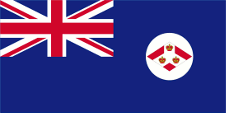 |
1879–1904, Flagge der Regierung (Staatsflagge) – flag of the government (state flag), Seitenverhältnis – ratio = 1:2, Quelle/Source, nach/by: Flags of the World   |
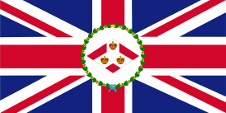 |
1879–1904, Flagge des Gouverneurs – flag of the Governor, Seitenverhältnis – ratio = 1:2, Quelle/Source, nach/by: Flags of the World |
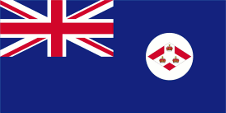 |
1904–1925, Flagge der Regierung (Staatsflagge) – flag of the government (state flag), Seitenverhältnis – ratio = 1:2, Quelle/Source, nach/by: Flags of the World   |
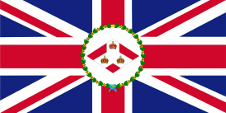 |
1904–1946, Flagge des Gouverneurs – flag of the Governor, Seitenverhältnis – ratio = 1:2, Quelle/Source, nach/by: Flags of the World |
 |
1925–1946, Flagge der Regierung (Staatsflagge) – flag of the government (state flag), Seitenverhältnis – ratio = 1:2, Quelle/Source, nach/by: Flags of the World   |
| Als die Kolonie der Straits Settlements im Jahre 1826 durch die Britische Ostindienkompanie geschaffen wurde, wurde hier deren Flagge bzw. der britische Union Jack verwendet. Die Flaggen der Ostindienkompanie zeigten seit Anfang des 17. Jahrhunderts weiße und rote Streifen, um deren Schiffe besser von anderen britischen Schiffen zu unterscheiden. |
When the Colony of the Straits Settlements was created in 1826 by the die
British East India Company, here was used its flag respectively the British
Union Jack. The flags of the East India Company showed since the beginning of the 17th century white and red stripes, to differentiate better its ships from the other British ships. |
| An Land, bis 1864 auch zur See, repräsentierten der einzelne Bürger und auch die Behörden ihren Status als Bürger oder Organe des United Kingdom, durch die Verwendung des Union Jack, "Union Flag" genannt. Im Jahre 1867 wurden die Straits Settlements eine britische Kronkolonie. Für diese wurde eine Flagge eingeführt, wie sie damals in britischen Kolonien üblich war. |
On land, and until 1864 also at sea, individual citizens and the authorities
represented their status as citizens or bodies of the United Kingdom by
using the Union Jack, known as the Union Flag. In the year 1867 the Straits Settlements became a British crown colony. For that was introduced a flag how it was usual at that times for British colonies. |
Großbritannien hatte in Jahr 1864 ein Flaggensystem eingeführt, in dem:
Seit 1865 durften Schiffe von Kolonialregierungen einen Blue Ensign mit einem Badge (Abzeichen) im fliegenden Ende verwenden. Für alle anderen Zwecke war ab diesem Zeitpunkt an Land ausschließlich der britische Union Jack zu verwenden und zur See die übliche rote britische Handelsflagge, der "Red Ensign". Wenn die britische Admiralität der Kolonie die entsprechende Erlaubnis erteilt hatte, durften Handelsschiffe und private Seeleute dieser Kolonien einen Red Ensign mit dem Bagde führen. Dies war für die Straits Settlements nicht der Fall. Die jeweiligen Regierungen sollten entsprechene Bagdes zur Verfügung stellen. |
United
Kingdom introduced a flag system in 1864 in which:
Since 1865, colonial government ships were permitted to use a Blue Ensign with a badge in the flying end. From this point on, only the British Union Jack was to be used for all other purposes on land and the usual red British merchant flag, the "Red Ensign", at sea. If the British Admiralty had granted the appropriate permission to one colony, merchant ships and private sailors from this colony were allowed to use a Red Ensign with the Bagde. This was not the case for the Straits Settlements. The respective governments should provide appropriate bagdes. |
| Ein solches Badge war oft eine auf einer Scheibe platzierte regionale landschaftliche Darstellung, zeigte oft Schiffe, historische Begebenheiten oder konnte auch nur eine Art Logo sein. Sehr oft zeigte ein Badge zusätzlich den Namen des Landes oder auch einen Wahlspruch. Einige Besitzungen hatten aber auch schon von Anfang an ein Wappen, bzw. erhielten über die Jahre eine eigenes Wappen und das Badge wurde abgeschafft. Um ein weitgehend einheitliches Erscheinungsbild im fliegenden Ende der Flaggen zu gewährleisten, wurden Wappen und auch andere Symbole auf einer weißen Scheibe in der Größe der früheren Badges dargestellt. Es gab hier aber auch Ausnahmen, denn einige Kolonien verwendeten diese weiße Scheibe nicht, und platzierten ihr Wappen oder auch nur das Wappenschild - manchmal auch vergrößert - direkt auf das Flaggentuch. Schon in den 40-er Jahren wurde dazu übergegangen die weißen Scheiben zu entfernen und das Wappen direkt zu platzieren oder vergrößert dazustellen. Dieser Umstellungsprozess erfolgte allmählich, nirgendwo gleichzeitig und vollständig. In einigen britischen Besitzungen sind bis heute Flaggen mit der weißen Scheibe in Gebrauch, in anderen nicht mehr und in einigen Gebieten gibt es beide Varianten nebeneinander. |
Such a badge was often a
regional landscape representation placed on a disk, often showed ships,
historical events or could just be a kind of logo. Very often a badge also
showed the name of the country or a motto. However, some possessions had a coat of arms right from the start, or received their own coat of arms over the years and the badge was abolished. In order to ensure a largely uniform appearance in the flying end of the flags, coats of arms and other symbols were displayed on a white disk the same size as the earlier badges. But there were exceptions here, as some colonies did not use this white disk and placed their coat of arms or just the shield – sometimes enlarged – directly on the flag cloth. As early as the 1940s, the white discs were removed and the coat of arms was placed directly or enlarged. This transition process occurred gradually, never simultaneously and completely. In some British possessions flags with the white disc are still in use, in others they are no longer used and in some areas both variants exist side by side. |
| Das Badge der Straits Settlements war ein roter Rhombus mit einer weißen Deichsel, auf die drei Kronen aufgelegt waren. Diese standen für die drei Besitzungen Pinang, Malakka und Singapur. | The badge of the Straits Settlements was a red rhombus with a white shaft on which were layed down three crowns. That stood for the three places of Penang, Malacca and Singapore. |
| Quelle/Source: Die Welt der Flaggen, Flags of the World, Volker Preuß | |
Wappen – Coat of Arms: |
|
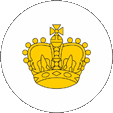 |
1868–1877, Emblem (Badge) der Straits Settlements – Badge of the Straits Settlements, Quelle/Source, nach by: Flags of the World |
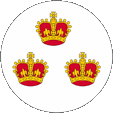 |
1877–1879,(?) unsicher – uncertain, Emblem (Badge) der Straits Settlements – Badge of the Straits Settlements, Quelle/Source, nach by: Flags of the World |
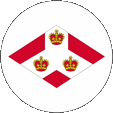 |
1879–1904, Emblem (Badge) der Straits Settlements – Badge of the Straits Settlements, Quelle/Source, nach by: Flags of the World |
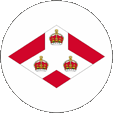 |
1904–1925, Emblem (Badge) der Straits Settlements – Badge of the Straits Settlements, Quelle/Source, nach by: Flags of the World |
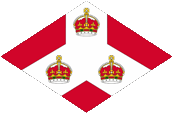 |
1904–1925, Emblem (Badge) der Straits Settlements – Badge of the Straits Settlements, Quelle/Source, nach by: Flags of the World |
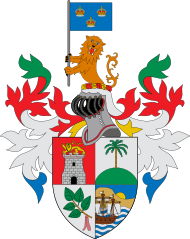 |
1874–1942, Wappen der Straits Settlements – Coat of Arms of the Straits Settlements, Quelle/Source: Xavi Garcia, CC BY-SA 3.0, via Wikimedia Commons |
| Das Wappen der Straits Settlements wurde wahrscheinlich 1874 geschaffen, als die Kolonie aus den Teilgebieten Pinang, Malakka und Singapur bestand. Insofern sind die drei Kronen wichtig, die im Wappen – genau so wie im Badge – auftauchen, denn jede dieser Kronen steht für eine dieser britischen Besitzungen. Das Schild des Wappens ist gevierteilt und zeigt ein rotes Feld mit einem Turm und einem Leoparden, ein silbernes Feld mit einem grünen Hügel und einer Palme darauf, ein weiteres silbernes Feld mit einem Zweig mit Blättern, der eine Frucht trägt. Ein weiteres Feld ist eine Landschaftsdarstellung, eine Küstenszene, die im Vordergrund ein Schiff vor einer Küste mit der aufgehenden Sonne zeigt. Oberhalb des Schild erscheint ein Helm, dessen Helmzier ein aufgerichteter Leopard ist, der eine hellblaue Fahne mit drei Kronen in den Fängen hält. Vor dem Wappen war im Jahre 1868 bereits ein Badge geschaffen worden, das auf der blauen Dienstflagge der Behörden gezeigt wurde. Es war eine einzige goldene Krone, die im wehenden Ende der Flagge nicht auf einer weißen Scheibe platziert war. Wirklich bekannt ist das Drei-Kronen-Badge, das um 1879 eingeführt worden war und bis zum Ende der Kolonie bestand hatte. Wahrscheinlich gab es davor schon für kurze Zeit eine Art Vorstufe dieses Badges, das auch schon drei Kronen zeigte auf einer weißen Scheibe zeigte. Das Badge von 1879 zeige die drei Kronen auf einem roten Rhombus mit einer weißen Deichsel, auf deren drei Armen jeweils eine Krone platziert war. Das Badge änderte sich im Jahre 1904 nur geringfügig, als die Kronen durch die damals übliche britische Krone ersetzt wurden. Auf der Flagge wurde ab 1925 auf die weiße Scheibe verzichtet. Diese Art der Darstellung war gewählt worden, um ein weitgehend einheitliches Erscheinungsbild im fliegenden Ende der Flaggen zu gewährleisten. Eine solche weiße Scheibe konnte auch komplette Wappen und auch andere Symbole enthalten. Es gab hier aber auch Ausnahmen, denn einige Kolonien verwendeten diese weiße Scheibe nicht, und platzierten ihr Wappen oder auch nur das Wappenschild - manchmal auch vergrößert - direkt auf das Flaggentuch. Schon in den 20-er Jahren wurde dazu übergegangen die weiße Scheibe zu entfernen und das Wappen direkt zu platzieren oder vergrößert dazustellen. Dieser Umstellungsprozess erfolgte allmählich, nirgendwo gleichzeitig und vollständig. In einigen britischen Besitzungen sind bis heute Flaggen mit der weißen Scheibe in Gebrauch, in anderen nicht mehr und in einigen Gebieten gibt es beide Varianten nebeneinander. |
The coat of arms of the
Straits Settlements was probably created in 1874, when the colony consisted
of the sub-territories of Pinang, Malacca and Singapore. In this respect,
the three crowns that appear in the coat of arms - just as they do in the
badge - are important, because each of these crowns stands for one of these
British possessions. The shield of the coat of arms is quartered and shows a red field with a tower and a leopard, a silver field with a green hill and a palm tree on it, another silver field with a branch with leaves bearing a fruit. Another field is a landscape depiction, a coastal scene, showing a ship in front of a coast with the rising sun in the foreground. Above the shield appears a helmet whose crest is an erect leopard holding a light blue flag with three crowns in its fangs. Before the coat of arms, a badge had already been created in 1868, which was shown on the blue service flag of the authorities. It was a single golden crown placed in the waving end of the flag not on a white disc. What is really known is the three-crown badge, which was introduced around 1879 and existed until the end of the colony. There was probably a kind of precursor to this badge for a short time before that, which also showed three crowns on a white disc. The badge of 1879 showed the three crowns on a red rhombus with a white drawbar, on each of whose three arms a crown was placed. The badge changed only slightly in 1904, when the crowns were replaced by the then used British crown. The white disc was dispensed with on the flag from 1925. This type of display had been chosen to ensure a largely uniform appearance in the flying end of the flags. Such a white disc could also contain complete coats of arms and also other symbols. There were exceptions, however, because some colonies did not use this white disc and placed their coat of arms or even just the escutcheon – sometimes enlarged – directly on the flag cloth. Already in the 1920s, the white disc was removed and the coat of arms was placed directly or enlarged. This change took place gradually, nowhere at the same time and completely. In some British possessions, flags with the white disc are still in use today, in others they are no longer, and in some areas both variants exist side by side. |
| Quelle/Source: Die Welt der Flaggen, Flags of the World, Volker Preuß | |
| interaktive Landkarten – interactive Maps |
| Straits Settelements ca. 1906: |
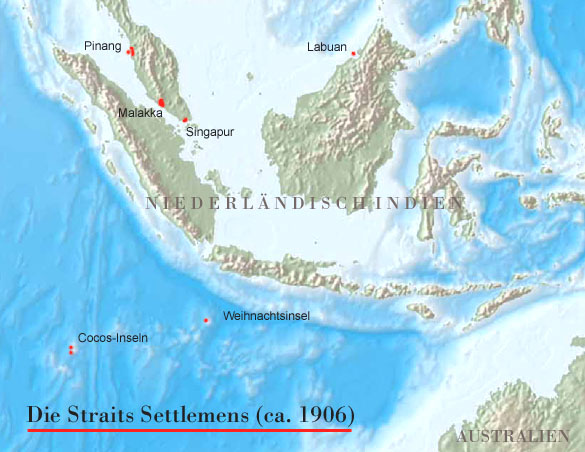 |
| Quelle/Source: Freeware, University of Texas Libraries, modyfied by: Volker Preuß |
| Die Bundesstaaten Malaysias – the Federal States of Malaysia: |
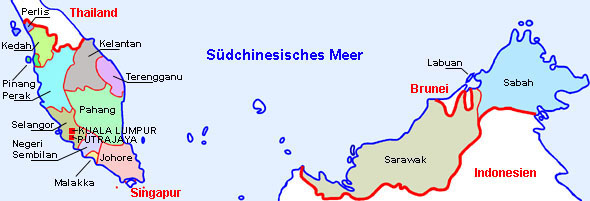 Landkarte/Map: Volker Preuß, nach/to Malaysia? → hier klicken – click here |
| Halbinsel Malaya – Malaya Peninsula: |
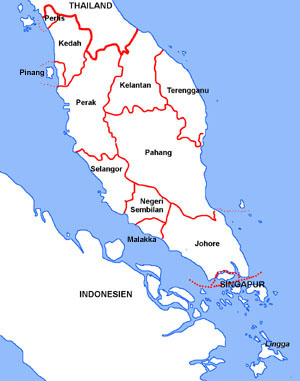 |
| Landkarte/map by: Volker Preuß |
| Zahlen und Fakten – Numbers and Facts: | |
|
|
|
|
|
|
|
|
|
|
|
|
|
|
|
|
|
1609
· der englische Seefahrer William Keeling entdeckt die Kokosinseln 1641 · Eroberung Malakkas durch die Niederländer 1643 · der englische Seefahrer William Mynors entdeckt die Weihnachtsinsel 1685 · die Britische Ostindienkompanie erwirbt die Besitzung Benkulen an der Südküste Sumatras 1786 · der Sultan von Kedah ruft gegen Siam (Thailand) die Britische Ostindienkompanie zu Hilfe, Francis Light besetzt die Insel Pinang und baut sie zu einem Stützpunkt aus 1795 · Eroberung Malakkas durch die Britische Ostindienkompanie 1800 · die Britische Ostindienkompanie erwirbt das Festland gegenüber von Pinang (Provinz Wellesley) 1818 · erneute Eroberung Malakkas durch die Niederländer 1819 · Sir Stamford Raffles von der Britischen Ostindienkompanie (East India Company) errichtet auf der Insel Singapur eine Handelsniederlassung 1824 · britisch-niederländischer Vertrag von London zur Abgrenzung der Interessensphären im Bereich des malaiischen Archipels, die Britische Ostindienkompanie erhält Malaya und den Norden der Insel Borneo (das heutige Singapur, Malaysia und Brunei), die Niederlande erhalten das heutige Indonesien, Gebietsaustausch: die Britische Ostindienkompanie tritt Benkulen an die Niederlande ab, die Niederlande treten Malakka an die Britische Ostindienkompanie ab 03.08.1824 · Sir Stamford Raffles und John Crawfurd erwerben die Insel Singapur vom Sultan von Lingga für die Britische Ostindienkompanie 14.08.1826 · Singapur wird mit Pinang und Malakka zur Kolonie "Straits Settlements" unter der Oberhoheit der Britischen Ostindienkompanie zusammengeschlossen, Verwaltungssitz ist Gerorgetown auf Pinang 1832 · der Verwaltungssitz der Straits Settlements wird von Pinang nach Singapur verlegt 1841 · der Sultan von Brunei muss die britische Oberhoheit über sein Land anerkennen, die Insel Labuan ist zu diesem Zeitpunkt ein Bestandteil des Sultanats Brunei 1857 · die Kokosinseln werden von der Britischen Ostindienkompanie in Besitz genommen 1858 · die Verwaltung der Straits Settlements geht auf Britisch-Indien über 01.04.1867 · die Straits Settlements werden britische Kronkolonie 1870 · die Verwaltung der Kokosinseln geht auf den Britischen Gouverneur von Ceylon (Sri Lanka) über 1873 · die Britische Ostindienkompanie wird aufgelöst 1886 · die Kokosinseln werden den Straits Settlements angegliedert 1888 · Großbritannien errichtet sein Protektorat über das Sultanat Brunei 1888 · die Weihnachstinsel wird von Großbritannien in Besitz genommen und den Straits Settlements angegliedert 1906 · Labuan wird vom Sultanat Brunei abgetrennt und den Straits Settlements angegliedert 1912 · Labuan wird wieder aus den Straits Settlements ausgegliedert 1942–1945 · die Straits Settlements sind im Zweiten Weltkrieg durch japanische Truppen besetzt 01.04.1946 · das Ende der Straits Settlements: Pinang und Malakka werden der Malaiischen Union (Malaya) angeschlossen, Singapur wird eine eigene britische Kronkolonie, die Kokosinseln und die Weihnachtsinsel werden Singapur angeschlossen, Labuan kommt an Britisch-Nordborneo 01.10.1958 · die Verwaltung der Weihnachtsinsel geht auf Australien über 31.08.1963 · Großbritannien gewährt Singapur die Unabhängigkeit 16.09.1963 · Proklamation des Königreiches Malaysia durch Zusammenschluss der Malaiischen Föderation (Malaya) mit den ehemaligen britischen Kolonien Sarawak, Sabah (Nordborneo) und Singapur. Brunei lehnte den Beitritt ab und verblieb bei Großbritannien 09.08.1965 · Singapur verlässt die Föderation Malaysia 1982 · Bildung des Bundesterritoriums Labuan |
|
1609
· the English seafarer William Keeling discovers the Cocos Islands 1641 · conquest of Malacca by the Netherlanders 1643 · the English seafarer William Mynors discovers Christmas Island 1685 · the British East India Company acquires the possession of Benkulen at the southern coast of Sumatra 1786 · the Sultan of Kedah calls for the British East India Company against Siam (Thailand), Francis Light occupies Penang Island and develops it to a base 1795 · conquest of Malacca by the British East India Company 1800 · the British East India Company acquires the mainland across from Pinang Island (Wellesley Province) 1818 · the Netherlanders conquer Malacca again 1819 · Sir Stamford Raffles from the British East India Company establishes on Singapore Island an agency 1824 · British-Dutch treaty of London for demarcation of the spheres of interest in the area of the Malaysian Archipelago, United Kingdom gets Malaya and the north of Borneo Island (the today’s Singapore, Malaysia and Brunei), the Netherlands get the today's Indonesia, exchange of territories: the British East India Company cedes Benkulen to the Netherlands, the Netherlands cede Malacca to the British East India Company 3rd of August 1824 · Sir Stamford Raffles and John Crawfurd purchase Singapore Island from the Sultan of Lingga for the British East India Company 14th of August 1826 · Singapore becomes joined with Penang and Malacca to the colony of the "Straits Settlements" under the supremacy of the British East India Company, seat of government is Gerorgetown on Pinang Island 1832 · the seat of government of the Straits Settlements becomes transfered from Penang to Singapore 1841 · the Sultan of Brunei has to accept the British supremacy over his country, Labuan Island is at that point in time a component of the Sultanate of Brunei 1857 · the Cocos Islands become appropriated by the British East India Company 1858 · the administration of the Straits Settlements becomes handed over to British India 1st of April 1867 · the Straits Settlements become a British crown colony 1870 · the administration of the Cocos Islands becomes handed over to the British Governor of Ceylon (Sri Lanka) 1873 · the British East India Company becomes dissolved 1886 · the Cocos Islands become annexed to the Straits Settlements 1888 · United Kingdom establishes its protectorate over the Sultanate of Brunei 1888 · Christmas Island becomes appropriated by United Kingdom and affiliated to the Straits Settlements 1906 · Labuan becomes separated from the Sultanate of Brunei and affiliated to the Straits Settlements 1912 · Labuan becomes excluded from the Straits Settlements 1942–1945 · the Straits Settlements are occupied by Japanese troops during the Second World War 1st of April 1946 · the end of the Straits Settlements: Penang and Malacca become affiliated to the Malay Union (Malaya), but Singapore becomes an own British crown colony, the Cocos Islands and Christmas Island become annexed to Singapore, Labuan comes to British North Borneo 1st of October 1958 · the administration of Christmas Island becomes transfered to Australia 31st of August 1963 · United Kingdom grants Singapore the independence 16th of September 1963 · proclamation of the Kingdom of Malaysia by confederation of the Malaysian Federation (Malaya) with the former British colonies Sarawak, Sabah (North Borneo) and Singapore, Brunei rejects the joining and remains at United Kingdom 9th of August 1965 · Singapore leaves the Federation of Malaysia 1982 · formation of the Federal Territory of Labuan |
| Quelle/Source: Wikipedia (EN), World Statesmen |
| Der Name "Straits Settlements" ist im Prinzip eine Verkürzung. Ausgeschrieben könne es heißen: "Siedlungen in der Straße von Malakka". | The name
"Straits Settlements" is in principle a shortening. Detailed it could be
named: "Settlements in the Strait of Malacca". |
| Quelle/Source: Volker Preuß | |